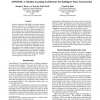286 search results - page 39 / 58 » Using inaccurate models in reinforcement learning |
BC
2008
13 years 7 months ago
2008
In this paper we introduce a simple model based on probabilistic finite state automata to describe an emotional interaction between a robot and a human user, or between simulated a...
SIGDIAL
2010
13 years 5 months ago
2010
This paper presents a spoken dialogue framework that helps users in making decisions. Users often do not have a definite goal or criteria for selecting from a list of alternatives...
AAAI
2000
13 years 9 months ago
2000
We have constructed ADVISOR, a two-agent machine learning architecture for intelligent tutoring systems (ITS). The purpose of this architecture is to centralize the reasoning of a...
AAMAS
2005
Springer
13 years 7 months ago
2005
Springer
Cooperative multi-agent systems are ones in which several agents attempt, through their interaction, to jointly solve tasks or to maximize utility. Due to the interactions among t...
ATAL
2008
Springer
13 years 9 months ago
2008
Springer
Recent advances in technology allow multi-agent systems to be deployed in cooperation with or as a service for humans. Typically, those systems are designed assuming individually ...



